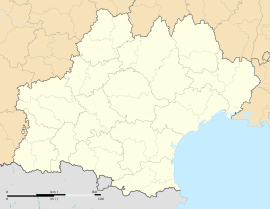Saint-Bauzille-de-la-Sylve
Saint-Bauzille-de-la-Sylve | |
|---|---|
 Town gate | |
| Coordinates: 43°37′05″N 3°32′49″E / 43.6181°N 3.5469°E | |
| Country | France |
| Region | Occitania |
| Department | Hérault |
| Arrondissement | Lodève |
| Canton | Gignac |
| Intercommunality | Vallée de l'Hérault |
| Government | |
| • Mayor (2020–2026) | Grégory Bro[1] |
| Area 1 | 8.63 km2 (3.33 sq mi) |
| Population (2021)[2] | 922 |
| • Density | 110/km2 (280/sq mi) |
| Time zone | UTC+01:00 (CET) |
| • Summer (DST) | UTC+02:00 (CEST) |
| INSEE/Postal code | 34241 /34230 |
| Elevation | 68–247 m (223–810 ft) (avg. 60 m or 200 ft) |
| 1 French Land Register data, which excludes lakes, ponds, glaciers > 1 km2 (0.386 sq mi or 247 acres) and river estuaries. | |
Saint-Bauzille-de-la-Sylve (French pronunciation: [sɛ̃ bozil də la silv]; Occitan: Sant Bausèli de la Seuva) is a commune in the Hérault department in the Occitanie region in southern France.
Geography
[edit]
Equidistant from the sea and the mountains, this village, located in the canton of Gignac, 33 kilometres (21 mi) west of Montpellier and near the banks of the Hérault River, is overlooked to the east by the imposing ruins of the Château d'Aumelas.
The neighboring communes are Gignac, Aumelas, Vendémian, Le Pouget, Popian.
Climate
[edit]In 2010, the climate of the commune is classified as a frank Mediterranean climate, according to a study based on a dataset covering the 1971-2000 period.[3] In 2020, Météo-France published a typology of climates in mainland France in which the commune is exposed to a Mediterranean climate and is part of the Provence, Languedoc-Roussillon climatic region, characterized by low rainfall in summer, very good sunshine (2,600 h/year), a hot summer 21.5 °C (71 °F), very dry air in summer, dry conditions in all seasons, strong winds (with a frequency of 40 to 50% for winds > 5 m/s), and little fog.[4]
For the 1971-2000 period, the average annual temperature was 14.2 °C (58 °F) with an annual atmospheric temperature of 16.4 °C (62 °F). The average annual total rainfall during this period was 782 mm, with 6.4 days of precipitation in January and 2.7 days in July.[3] For the subsequent period of 1991 to 2020, the average annual temperature observed at the nearest weather station, located in the commune of Saint-André-de-Sangonis, 5 kilometres (3 mi) away as the crow flies,[5] is 15.5 °C (60 °F), and the average annual total rainfall is 652.4 mm.[6][7]
For the future, climate parameters for the commune projected for 2050, based on different greenhouse gas emission scenarios, can be consulted on a dedicated website published by Météo-France in November 2022.[8]
Population
[edit]Changes in the number of inhabitants have been documented through population censuses conducted in the commune since 1793. For communes with fewer than 10,000 inhabitants, a full census of the population is conducted every five years, with the legal populations for the intervening years estimated through interpolation or extrapolation.[9] For this commune, the first complete census under the new system was carried out in 2005.[10]
In 2021, the commune had a population of 922,[Note 1] reflecting an increase of +12,3 % since 2015 (Hérault: +7.29%, France excluding Mayotte: +1.84%).
|
| |||||||||||||||||||||||||||||||||||||||||||||||||||||||||||||||||||||||||||||||||||||||||||||||||||||||||||||||||||||||||||
| Source: Ldh/EHESS/Cassini until 1999,[11] and INSEE since 2006.[12] | ||||||||||||||||||||||||||||||||||||||||||||||||||||||||||||||||||||||||||||||||||||||||||||||||||||||||||||||||||||||||||||
See also
[edit]Notes and references
[edit]Notes
[edit]- ^ Legal municipal population effective as of January 1, 2024, based on 2021 data, defined within the territorial boundaries effective as of January 1, 2023, with a statistical reference date of January 1, 2021.
References
[edit]- ^ "Répertoire national des élus: les maires". data.gouv.fr, Plateforme ouverte des données publiques françaises (in French). 2 December 2020.
- ^ "Populations légales 2021" (in French). The National Institute of Statistics and Economic Studies. 28 December 2023.
- ^ a b Joly, Daniel; Brossard, Thierry; Cardot, Hervé; Cavailhes, Jean; Hilal, Mohamed; Wavresky, Pierre (18 June 2010). "Climate Types in France: A Spatial Construction". Cybergéo, European Journal of Geography (501). doi:10.4000/cybergeo.23155. Retrieved 26 October 2024.
- ^ "Zonages climatiques en France métropolitaine". pluiesextremes.meteo.fr. Retrieved 3 March 2024.
- ^ "Orthodromie entre Saint-Bauzille-de-la-Sylve et Saint-André-de-Sangonis". fr.distance.to. Retrieved 3 March 2024.
- ^ "Station Météo-France « St Andre De Sangonis » (commune de Saint-André-de-Sangonis) - fiche climatologique - période 1991-2020" (PDF). donneespubliques.meteofrance.fr. Retrieved 3 March 2024.
- ^ "Station Météo-France « St Andre De Sangonis » (commune de Saint-André-de-Sangonis) - fiche de métadonnées" (PDF). donneespubliques.meteofrance.fr. Retrieved 3 March 2024.
- ^ "Climadiag Commune:diagnostiquez les enjeux climatiques de votre collectivité". meteofrance.fr (in French). November 2022. Retrieved 25 October 2024.
- ^ "L'organisation du recensement". insee.fr.
- ^ "Calendrier départemental des recensements". insee.fr.
- ^ "Des villages de Cassini aux communes d'aujourd'hui". École des hautes études en sciences sociales (in French). Retrieved 25 October 2024.
- ^
Statistical data from INSEE for various years:
- 2006: INSEE 2006
- 2007: INSEE 2007
- 2008: INSEE 2008
- 2009: INSEE 2009
- 2010: INSEE 2010
- 2011: INSEE 2011
- 2012: INSEE 2012
- 2013: INSEE 2013
- 2014: INSEE 2014
- 2015: INSEE 2015
- 2016: INSEE 2016
- 2017: INSEE 2017
- 2018: INSEE 2018
- 2019: INSEE 2019
- 2020: INSEE 2020
- 2021: INSEE 2021




